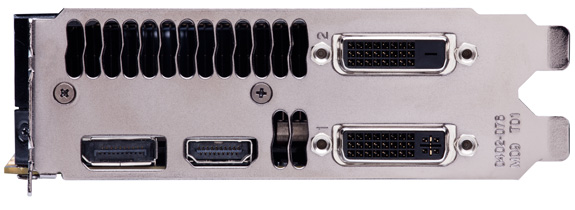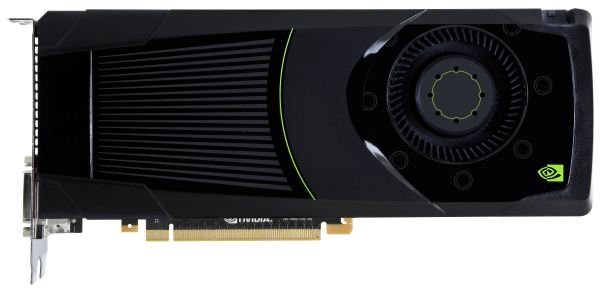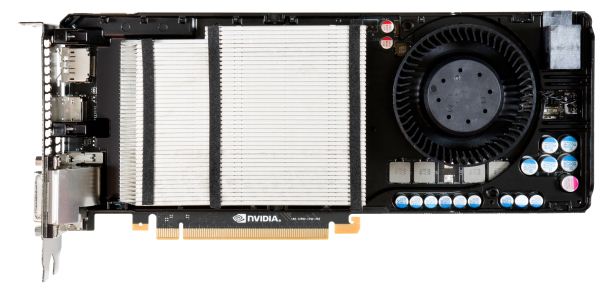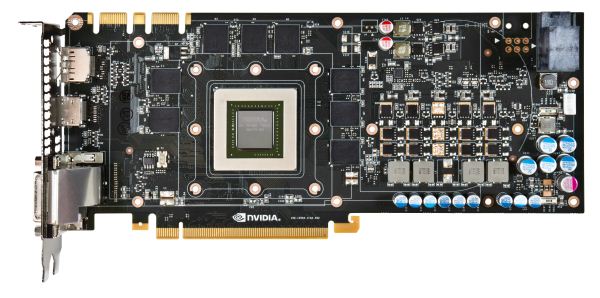NVIDIA GeForce GTX 680 Review: Retaking The Performance Crown
by Ryan Smith on March 22, 2012 9:00 AM ESTMeet the GeForce GTX 680
All things considered the design of the GeForce GTX 680 is not a radical departure from the GTX 580, but at the same time it also has some distinct differences owing to the fact that its TDP is some 50W lower than GTX 580.
Like the past GTX x80 cards, the basic design of the GTX 680 is that of a blower. A radial fan at the rear of the card sucks in air and pushes it towards the front of the card. Notably, due to a combination of card length and the fan position, the “wedge” around the fan has been done away with. NVIDIA tells us that this shouldn’t significantly impact the cooling of the card, particularly since it has a lower TDP in the first place, but when used in SLI it will remove some of the breathing room than the GTX 580 enjoyed.
Looking at the fan itself, compared to the GTX 580 the fan has been moved from the center of the card to the top of the card. This is due to NVIDIA’s port configuration, which uses a stacked DVI connector that consumes what would have normally been part of the exhaust vent on the GTX 580. We’ll get into the port configuration more in a minute, but for the moment the significance is that because the GTX 680 only has half a vent NVIDIA has moved the fan to match the vent, which is why the fan has been moved up.
On that note, the repositioning of the fan also had its own ramifications. Because the fan is now so close to the top and at the same time so close to the rear, NVIDIA went with a unique method of arranging the PCIe power sockets. Rather than having them side-by-side as we’ve seen on countless NVIDIA cards in the past, the sockets are stacked on each other in a staggered configuration. With the fan otherwise occupying the space that one of the sockets would take up, this configuration allowed NVIDIA to have two sockets without lengthening the card just to fit another socket. Overall this staggered design is not too difficult to work with, though with one socket facing the opposite way it might require some cable repositioning if you have a well maintained cable run.
Moving on, when we remove the shroud on the GTX 680 we see the fan, baseplate, and heatsink in full detail. NVIDIA is using an aluminum fin stacked heatsink, very similar to what we saw on the GTX 580. Underneath the heatsink NVIDIA is using a set of three heatpipes to transfer heat between the GPU and the heatsink. This is as opposed to the vapor chamber on the GTX 580, and while this setup doesn’t allow empirical testing, given the high efficiency of vapor chambers it’s likely that this isn’t quite as efficient, though to what degree we couldn’t say.
Finally, after removing the fan, baseplate, and heatsink, we can see the PCB in full detail. Unlike GF110 and GF114, GK104 is not capped with an IHS, allowing for the heatsink to directly come in contact with the GPU die. Meanwhile arranged around the GPU we can see the 8 2Gb GDDR5 RAM modules that give the GTX 680 its 2GB of RAM. These are Hynix R0C modules, which means they’re rated for 6GHz, the stock memory speed for the GTX 680. Overall the card measures 10” long with no overhang from the shroud, making it 0.5” shorter than the GTX 580.
Looking at the top of the card, as always we see the SLI connectors. Following in the footsteps of the GTX 580, the GTX 680 features 2 SLI connectors, allowing for up to 3-way SLI.
Meanwhile at the front of the card we see the I/O bracket. As we alluded to previously, the GTX 680 uses a stacked DVI design here; NVIDIA has done everything they can to keep the DVI ports at the very bottom of the card to avoid impeding airflow, but the upper DVI port still occupies roughly 40% of what would otherwise be the vent. Altogether the GTX 680 features 2 DL-DVI ports, a full size HDMI port, and a full size DisplayPort.

While NVIDIA has used DVI and HDMI ports for quite some time, this is the first time NVIDIA has included DIsplayPort on a reference design. Unfortunately we find that this ruffles our feathers a bit, although this isn’t strictly NVIDIA’s fault. As we’ve covered in the past, DisplayPort comes in both a full size and miniDP configuration – AMD in particular has used miniDP since the Radeon HD 6800 series in 2010. And while we’re happy to see DisplayPort finally make it into an NVIDIA reference design, the fact that it’s a full size DisplayPort is less than encouraging because at this point in time DisplayPort has largely been replaced by miniDP.
Ultimately the fault for this lies more with the VESA than NVIDIA, but it’s indicative of a larger problem in the DisplayPort community in that both full size DP and miniDP are equally valid and equally capable ports. While full size DisplayPort has the distinction of coming first, thanks in large part to Apple it has largely been displaced by miniDP as the most common variant on source devices. The problem with this is that both miniDP and DisplayPort are now in wide use; wide, redundant use.
At this point desktop computers and video cards coming with full size DisplayPorts is silly at best, and frustrating at worst. The laptop guys aren’t going to give up miniDP due to the space savings, and there’s no significantly good reason to use DisplayPort on desktops when miniDP offers the same functionality. We would rather see the PC industry standardize on miniDP across all source devices, and thereby eliminate any ambiguity with regards to what cables or adaptors are necessary. DisplayPort adoption has been slow enough – having 2 variants of the port on source devices only makes it more confusing for everyone.
Finally, while we’re on the subject of display connectivity we quickly took a look at how the idle clockspeeds of GTX 680 are impacted by the use of multiple displays. With 2 displays GTX 680 can utilize its full idle clocks, but only if both displays are connected via a TMDS type connection (DVI/HDMI) and run with identical timings. But if different timings are used or if one display is connected via DisplayPort, then the GTX 680 will shift to its low power 3D clocks. However if we expand that to 3 monitors and enable NVIDIA Surround, then the GTX 680 can operate at full idle regardless of whether DisplayPort is used or not.













404 Comments
View All Comments
blppt - Thursday, March 22, 2012 - link
Wondering if you guys could also add a benchmark for one the current crop of 1ghz core 7970s that are available now (if you've tested any). Otherwise, great review.tipoo - Thursday, March 22, 2012 - link
With everything being said by Nvidia, I thought this would be a Geforce 8k series class jump, while its really nothing close to that and trades blows with AMDs 3 month old card. GCN definitely had headroom so I can see lower priced, higher clocked AMD cards coming out soon to combat this. Still, I'm glad this will bring things down to sane prices.MarkusN - Thursday, March 22, 2012 - link
Well to be honest, this wasn't supposed to be Nvidias successor to the GTX 580 anyway. This graphics card replaced the GTX 560 Ti, not the GTX 580. GK 110 will replace the GTX 580, even if you can argue that the GTX 680 is now their high-end card, it's just a replacement for the GTX 560 Ti so I can just dream about the performance of the GTX 780 or whatever they're going to call it. ;)tipoo - Thursday, March 22, 2012 - link
I didn't know that, thanks. Ugh, even more confusing naming schemes.Articuno - Thursday, March 22, 2012 - link
If this is supposed to replace the 560 Ti then why does it cost $500 and why was it released before the low-end parts instead of before the high-end parts?MarkusN - Thursday, March 22, 2012 - link
It costs that much because Nvidia realized that it outperforms/trades blows with the HD 7970 and saw an opportunity to make some extra cash, which basically sucks for us consumers. There are those that say that the GTX 680 is cheaper and better than the HD 7970 and think it costs just the right amount, but as usual it's us, the customers, that are getting the shaft again. This card should've been around $300-350 in my opinion, no matter if it beats the HD 7970.coldpower27 - Thursday, March 22, 2012 - link
Nah, they aren't obligated to give more then what the market will bear, no sense in starting a price war when they can have much fatter margins, it beats the 7970 already it's just enough.Now the ball is in AMD's court let's see if they can drop prices to compete $450 would be a nice start, but $400 is necessary to actually cause significant competition.
CeriseCogburn - Friday, March 23, 2012 - link
This whole thing is so nutso but everyone is saying it.Let's take a thoughtful sane view...
The GTX580 flagship was just $500, and a week or two ago it was $469 or so.
In what world, in what release, in the past let's say ten years even, has either card company released their new product with $170 or $200 off their standard flagship price when it was standing near $500 right before the release ?
The answer is it has never, ever happened, not even close, not once.
With the GTX580 at $450, there's no way a card 40% faster is going to be dropped in at $300, no matter what rumor Charlie Demejerin at Semi0-Accurate has made up from thin air up as an attack on Nvidia, a very smart one for not too bright people it seems.
Please, feel free to tell me what flagship has ever dropped in cutting nearly $200 off the current flagship price ?
Any of you ?!?
Lepton87 - Thursday, March 22, 2012 - link
Because nVidia decided to screw its costumer and nickle and dime them. That's why. All because 7970 underperformed and nv could get away with it.JarredWalton - Thursday, March 22, 2012 - link
Or: Because NVIDIA and AMD and Intel are all businesses, and when you launch a hot new product and lots of people are excited to get one, you sell at a price premium for as long as you can. Then supply equals demand and then exceeds demand and that's when you start dropping prices. 7970 didn't underperform; people just expected/wanted more. Realistically, we're getting to the point where doubling performance with a process shrink isn't going to happen, and even 50% improvements are rare. 7970 and 680 are a reflection of that fact.